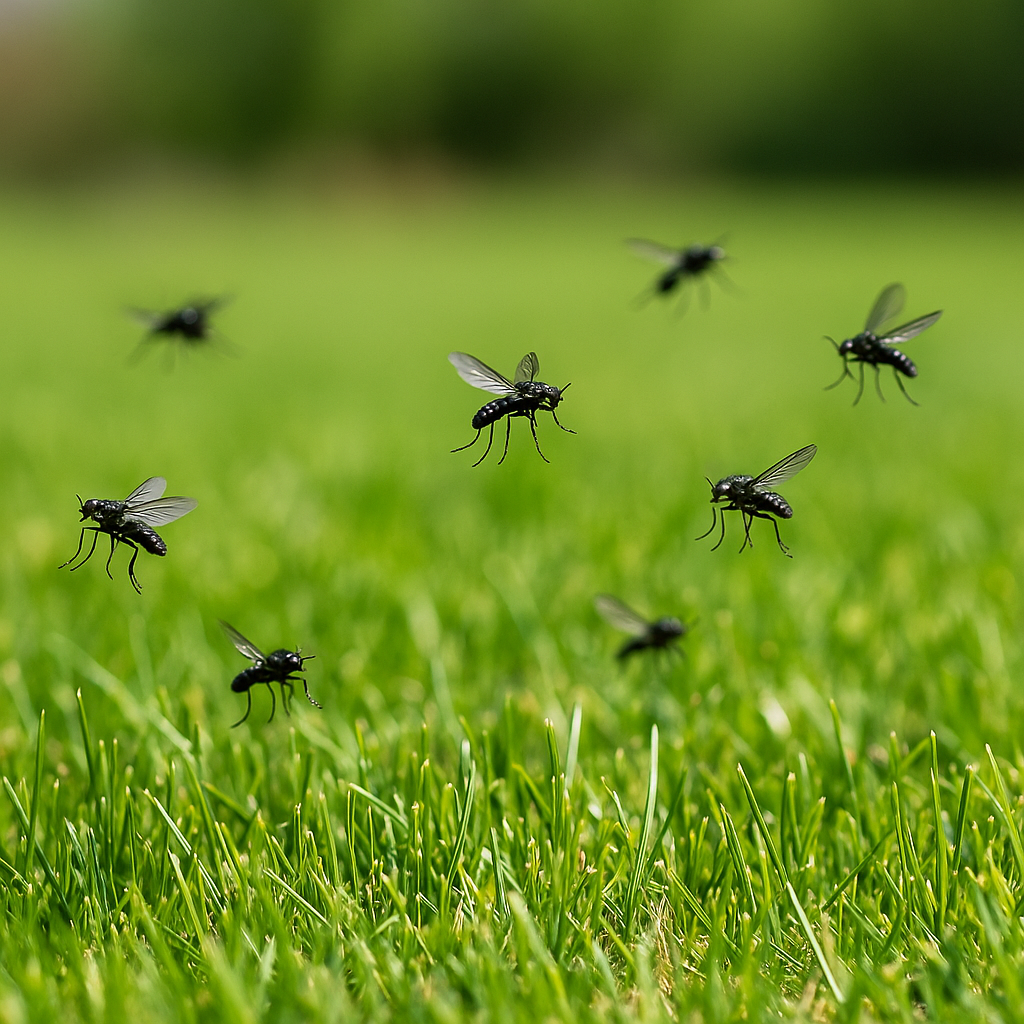- Lawn Turf
- Artificial
- Soil
- Timber
- Composite Decking
- Paving & Stone
Get In Touch With Our Experts Today!
Give us a Call! - Seed & Fertiliser
- Dressing
- Bark

July 24, 2025 TurfTurf AdviceTurf Tips
Nature can be turf’s biggest supporter but also its biggest hindrance. Especially, natural critters such as the bibionid fly. These are an essential part of the ecosystem, but they can also be a seasonal nuisance that affects the health and appearance of your lawn.
In this blog, we’ll explore what bibionid flies are, the kind of damage they can cause to your turf, and most importantly, how to get on top of the problem before it takes root.
These are bibionid flies! To many, bibionid flies will just look like another fly. But they are smaller, narrower, black flies with long legs and short wings. They are also known to be quite clumsy, and they like to hover over our lawns in large numbers – so you can’t miss them!
Although adult bibionid flies don’t harm turf, their larvae can cause serious problems. Bibionid flies lay around 30 eggs at a time, with the larvae appearing as small, white or grey grubs with dark heads. When they fall onto your turf, they burrow into and live in the soil. They also feed on organic matter, stealing essential nutrients that grass roots require for healthy growth. Bibionid fly larvae will also feed on grass roots and break vital root structures. At this point, you will start to notice serious turf damage.
The following issues are common signs of a bibionid fly problem within your turf:
Like most turf issues, there is always a solution to protect your lawn. In the case of bibionid flies, there are five proven solutions…
It is important to stay vigilant during spring and autumn, the peak times for bibionid fly infestation. Whether it is your own lawn or you are advising a client, regularly look under your turf for signs of larvae, especially if you notice weak or yellowing areas.
Bibionid larvae thrive in damp soil, which is often caused by poor drainage. A quick solution is to regularly aerate your entire lawn or struggling patches. Aeration helps the soil absorb water, hydrate your turf and produce a healthy lawn, making it less appealing to pests.
A strong, well-fed lawn will be more resilient to pests and the damage they cause. Applying a spring and autumn fertiliser will provide your turf with all the nutrients it needs to combat weeds and pests, resulting in a robust and healthy lawn.
This is more suited to smaller gardens and minor bibionid infestations. When you lift your turf, you can visibly see the white, bibionid larvae. You can remove these to help reduce the population and restore your turf’s health.
If your bibionid infestation is severe or recurring, you may need to speak to a pest control or turf specialist. At George Davies, our experts can help advise on the best turf treatment and products to resolve the issue and bring your lawn back to life!
Ultimately, like most turf issues, prevention is key! With bibionid flies, the best form of prevention is maintaining a resilient, well-cared-for lawn.
Bibionid flies are a natural part of our ecosystem. Also known as the Fever Fly or St Mark’s Fly, they love warm weather and are often spotted flying low over your lawn on summer days. They usually appear between May and September. This is when they lay their eggs, which hatch in late summer.
Due to this cycle, damage to your turf will appear in the winter months when damp conditions are higher and more consistent. They’re attracted to poorly maintained and moist lawns, so investing in good-quality turf and implementing a thorough lawn maintenance plan can help keep bibionid flies at bay.
Small areas infected by bibionid larvae can be easily fixed. Start by ridding the area of the infestation and aerating to aid with drainage. Next, apply a seasonal fertiliser to restore your lawn’s nutrients and rebuild its strength. If your lawn is still patchy, use high-quality grass seed in the affected areas to fill the gaps. You can also add a thin layer of topsoil to keep the grass seeds in place. Remember to read our blog on how to stop birds from eating your grass seeds for ultimate results.
If the bibionid larvae have caused serious, long-term damage, installing new turf may be the best option – saving you both time, money and effort. We offer a wide range of high-quality, natural grass products for domestic and commercial lawns.
Our team are on hand to answer all your turf queries. Head to our helpful library of turf insights or contact our experts for professional advice on repairing and maintaining your turf. For landscapers, check out our Trade Account for additional project support.